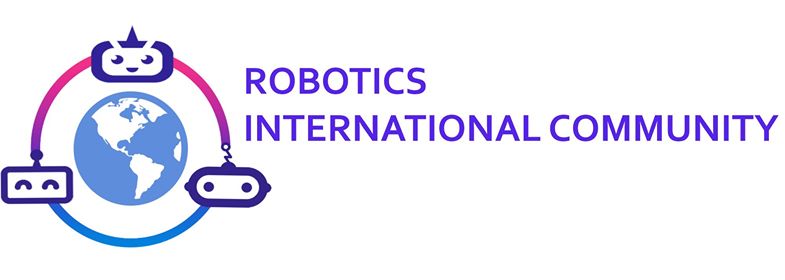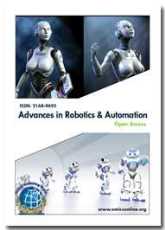Hear, Explore and learn the latest research. Present before distinguished global audience. Collaborate, build partnerships and experience London. Join the global academic community.
ConferenceSeries LLC Ltd invites all the participants across the globe to attend the Webinar on 8th International Conference on Robotics and Artificial Intelligence during August 10-11, 2020. Robotics and Artificial Intelligence 2020 includes prompt keynote presentations, Oral talks, Poster presentations and Exhibitions.
|
Conference Name
|
Place
|
Date
|
|
Euro Robotics 2020
|
Webinar(Online)
|
August 10-11, 2020
|
Euro Robotics 2020 aims in proclaim knowledge and share new ideas amongst the professionals, industrialists and students from research area of Robotics and Artificial Intelligence to share their research experiences and indulge in interactive discussions at the event. This scientific gathering guarantees that offering the thoughts and ideas will enable and secure you the theme "Development And Upgradation Of Robots Through AI". Artificial Intelligence is the latest trending technology in many fields especially in industries like manufacturing, control systems, mining, etc. The current era fully rolled out with many new automation technologies. In such case more automation companies and industries were newly introduced within market which obviously shows the market growth of Automation. While analysing the revenue growth of artificial intelligence functions, it highly developed from $250 billion USD to $450 billion USD since from 2015-2019. And the annual growth percentage increases from 45-65 percentages, which clearly shows that artificial intelligence technology contains huge scope in coming years.
Importance and Scope:
Due to incredible technology development, the industries are trying to reduce man power where they trying to increase Artificial intelligence and function in various sectors. Now robotics is used in each and every company where machines are involved and some or other process is involved. Many fields like robotics, mechatronics, control systems, electronics, wireless, laser technology, automotive motors are depended only on this Artificial Intelligence and Automation functions. The conference organizers aim is to gather the researcher’s academicians and scientists from the field of Industrial Robotics community and to create an approach towards global exchange of information on technological advances, new scientific innovations, and the effectiveness of various regulatory programs towards industrial robotics.
Why to attend?
With members from around the world focused on learning about robotics and artificial intelligence technologies, this is your single best opportunity to reach the largest assemblage of participants from the Robotics and Artificial Intelligence community. Conduct demonstrations, distribute information, acquire knowledge about current and trending robotic and artificial intelligence technologies, make a splash with a new research, and receive name recognition at this 3-day event. World-renowned speakers, the most recent techniques, tactics, and the newest updates in Industrial Robotics fields are hallmarks of this conference.
Target Audience:
Automation and Robotics Lab Directors/Associates
Head of the Departments from the field of Artificial intelligence, Robotics, Mechatronics, Control systems
Artificial intelligence researchers and academicians
Robotics doctorates
Control systems and Mechatronics expertise
Professors and Students from Academia in the study of Industrial robotics and artificial intelligence field.
Artificial Intelligence Lab Directors/Associates
Control systems and Mechatronics expertise
Conference Highlights
Robotics
Robotics and Screw Theory
Human-Robot Interaction
Industrial Applications of Robots
Bioengineering and Biomechanics
Robotics and Mechatronics
Micro Electro Mechanical Systems (MEMS) and Micro Robots
Robot Manipulators
Artificial Intelligence
Medical Robotics
Multi-Robot System
Remote and Telerobotics
Robot Localization and Map Building
Mobile Robot
Humanoid Robots
Neural Networks
Marine Robotics
Aerial robotics and UAV
Role of 3D printing in robotics
Intelligent Autonomous systems and Robots
Special Issues:
All accepted abstracts will be published in all respective International Journals.
Abstracts will be provided with Digital Object Identifier by Cross Ref.
See more at: http://smartrobotics.conferenceseries.com/
A
robot is a reprogrammable,
multifunctional manipulator designed to move material, parts, tools or specialized devices through
variable programmed motions for the performance of a variety of tasks.
Robots are the largest growing technological devices in the world. They perform many functions ranging from space exploration to entertainment.
Robots can be used in any situation and for any purpose, but today many are used in dangerous environments, manufacturing processes, or where humans cannot survive. Robots can take on any form but some are made to resemble humans in appearance. This is said to help in the acceptance of a robot in certain replicative behaviours usually performed by people. Such robots attempt to replicate walking, lifting, speech, cognition, and basically anything a human can do. Many of today's robots are inspired by nature, contributing to the field of
bio-inspired robotics.
Screw theory is the algebra and calculus of pairs of vectors, such as forces and moments and angular and linear velocity that arise in the kinematics and dynamics of rigid bodies. The motion of a particle mass is easy to describe because its configuration can be associated to a point of the three-dimensional
Euclidean space. After having chosen coordinates, each point can be associated to a triple of real numbers in R3 but the most important thing is that the algebraic and
topological properties of R3 correspond to real physical properties of the motion of the particle forces can be added velocity vectors too magnitudes of vectors correspond to magnitudes of forces and velocities orthogonally of a force and velocity vector gives zero power the velocity and acceleration.
Human–robot interaction is the study of interactions between humans and
robots. It is often referred as HRI by researchers. Human–robot interaction is a multidisciplinary field with contributions from
human–computer interaction,
artificial intelligence,
robotics, natural language understanding, design, and social sciences.
Human–robot interaction has been a topic of both science fiction and academic speculation even before any robots existed. Because HRI depends on knowledge of (sometimes natural) human communication, many aspects of HRI are continuations of human communications topics that are much older than robotics.
Sophisticated technology, for a majority of manufacturing activities in fabrication, forming, machining and assembly facilities, will be a significant contributor to productivity improvement with substantial gains in the quality of products in the face of tough challenge and competition
Industrial Robots have been in use for about 50 years. The Present-Day
Robots at Work: Industrial Robots have come to play a widespread and crucial role in many industrial operations today. These robots are almost always of the
Jacquard type—with few human features— rather than the
Jacquet-Droz, doll-like style. The work that robots do can be classified into three major categories: in the assembly and finishing of products; in the movement of materials and objects; and in the performance of work in environmentally difficult or
hazardous situations.
Robotics is the branch of innovation that arrangements with the configuration, development, operation, and utilization o
f robots.
Mechatronics is the branch of science that consolidating hardware and
mechanical designing. These incorporate Bio-enlivened movement for wheeled portable
robots, Potential utilization of robots on additional physical bodies, Pneumatic counterfeit muscles for mechanical hand and Aero-space apply autonomy and challenges.
Robot manipulators are created from a sequence of link and joint combinations. The links are the rigid members connecting the joints, or axes. The axes are the movable components of the
robotic manipulator that cause relative motion between adjoining links. The mechanical joints used to construct
robotic arm manipulator consist of five principal types. Two of the joints are linear, in which the relative motion between adjacent links is non-rotational, and three are rotary types, in which the relative motion involves rotation between links.
Artificial intelligence is a
behaviour based-system concept in
robot. Artificial Intelligence brings intelligent behaviour to the robot to be able to provide services to humans in unpredictable and changing environments, such as homes, hospitals, the work place, and all around us
Artificial Intelligence is a way of making a computer, a
computer-controlled robot, or a software think intelligently, in the similar manner the intelligent humans think. Artificial intelligence is accomplished by studying how human brain thinks and how humans learn, decide, and work while trying to solve a problem, and then using the outcomes of this study as a basis of developing intelligent software and systems. In the real world, the knowledge has some unwelcomed properties.
Medical robotics is an interesting discipline that is related to human health of all individuals. Their use is becoming popular due to their numerous advantages in the medical field.
Medical robotics is a stimulating and modern field in medical science that involves numerous operations and extensive use of telepresence. The discipline of
telepresence signifies the technologies that permit an individual to sense as if they were at another location without being actually there.
Robots are utilized in the discipline of medicine to execute operations that are normally performed manually by human beings.
Multi-robot system configuration
control algorithms must be able to sense the geometry of the network. The most common sensor models assume that either only the ranges between robots is known, or that there is a global coordinate system. However, range-only models require extensive computation to produce useful geometric information, and global coordinates might not be available in all environments. The local network geometry model is a compromise between these two that is well-suited to
multi-robot systems.
Telerobotics is the area of
robotics concerned with the control of
semi-autonomous robots from a distance, chiefly using Wireless network (like Wi-Fi, Bluetooth, the Deep Space Network, and similar) or tethered connections. It is a combination of two major subfields,
teleportation and telepresence.
Robot localization is a collection of state estimation nodes, each of which is an implementation of a nonlinear state estimator for robots moving in 3D space. It contains two state estimation nodes, ekf_localization_node and ukf_localization_node.In addition, robot localization provides navsat_transform_node, which aids in the integration of GPS data.
Robotic mapping is a discipline related to cartography. The goal for an
autonomous robot is to be able to construct (or use) a map or floor plan and to localize itself in it.
Robotic mapping is that branch of one, which deals with the study and application of ability to construct map or floor plan by the autonomous robot and to localize itself in it.
A
mobile robot is an automatic machine that is capable of
locomotion. A
spying robot is an example of a
mobile robot capable of movement in a given environment. Mobile robots have the capability to move around in their environment and are not fixed to one physical location.
A
humanoid robot is a robot with its body shape built to resemble the human body. A
humanoid design might be for functional purposes, such as interacting with human tools and environments, for experimental purposes, such as the study of
bipedal locomotion, or for other purposes. In general, humanoid robots have a torso, a head, two arms, and two legs; though some forms of humanoid robots may model only part of the body, for example, from the waist up. Some humanoid robots also have heads designed to replicate human facial features such as eyes and mouths. Androids are
humanoid robots built to aesthetically resemble humans.
Neural networks are a computational approach which is based on a large collection of neural units loosely modelling the way a biological brain solves problems with large clusters of
biological neurons connected by axons. Each neural unit is connected with many others, and links can be enforcing or inhibitory in their effect on the activation state of connected neural units. Each individual neural unit may have a summation function which combines the values of all its inputs together. The goal of the
neural network is to solve problems in the same way that the human brain would, although several neural networks are much more abstract. Modern neural network projects typically work with a few thousand to a few million neural units and millions of connections, which is still several orders of magnitude less complex than the human brain and closer to the computing power of a worm.New brain research often stimulates new patterns in neural networks. One new approach is using connections which span much further and link processing layers rather than always being localized to adjacent neurons.
Recently,
Marine Robotics has grown from
nascent navigation and
control algorithms for underwater and
surface vehicles, to powered autonomous underwater vehicles routinely able to dive beyond 6000 meters. We have seen underwater gliders cross the Atlantic Ocean and
unmanned surface platforms (Wave Gliders) cross the Pacific.
Marine Robotics as a field is set up to make a major contribution to understanding large scale societal problems. Emerging marine robotic developments will afford scientists advanced tools to explore and exploit the oceans at an unprecedented scale, in a sustainable manner.
Flying opens new opportunities to
robotically perform services and tasks like search and rescue, observation,
mapping or even inspection and maintenance. As such, substantial interest in
aerial robots has grown in recent years. Key areas to be addressed include, but are not limited to,
innovative Unmanned Aerial Vehicles design,
autonomous missions, guidance, navigation and control, airworthiness, safety and certification, risk assessment, multi-vehicle coordination, UAS traffic management (UTM).
. The technology is used by researchers, companies and home users. Small, unique and custom 3D printed parts match the low volumes of custom or new robots best. Robots are often customized for particular applications. In applications such as
customizing robot grippers or improving a robot on a production line, 3D printing can provide fast low cost solutions.When prototyping new robots or making small series of robots 3D printing can be used as a manufacturing technology. Exciting new applications such as 3D printing soft robotics or making integrated robots through 3D printing are frontiers that are beginning to be explored.















